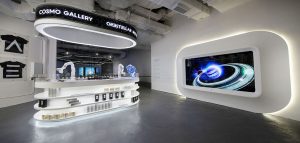On August 12, a whole galaxy opened up at the Pacific Place complex in Hong Kong in the form of a digital art installation. Orbstellar Metaspace transports visitors past 3D stars and orbs, as part of an immersive and intergalactic journey through space. Along the way, audiences are invited to create their own planet, via a gamified format, that will be minted as a NFT — in a suitably constellation-backed meeting between immersive and Web3 technologies.
The project is the latest from XCEPT, an innovation studio, commissioned by property developer Swire Properties on the occasion of its 50th year. As part of that milestone, the firm has launched a year-long Arts and Cultural Programme to further its placemaking for innovative projects. In addition to Orbstellar Metaspace, which emerges from 2021’s Orbstellar, XCEPT’s founder and artist Chris Cheung will be one of 10 international artists that will create NFT artworks for Swire Properties’ 50 Anniversary Digital Art Collection, some editions of which will be gifted to the developer’s community when the collection is released in November.

Orbstellar Metaspace invites visitors to scan QR codes corresponding to minerals, with which they can use to build their own planets in the form of NFTs. Image: Swire Properties
Per Swire’s spokesperson, the move into the NFT field comes naturally for a company that’s long entrenched in cultural engagement. “Web3 presents new opportunities for facilitating idea exchange, and infusing arts and culture into daily life within Swire Properties’ communities,” they tell Jing Culture & Commerce.
That notion gels with Cheung’s (and by extension, XCEPT’s) approach to Orbstellar Metaspace. “Young generations have already been born into the era of Web3,” he tells us. “Traditional media won’t raise their interest or attention.” Hence the installation’s blend of immersion and NFTs as much as creativity, co-creation, and commerce to meet the expectations of a post-pandemic, digitally native audience. Here’s more from Cheung on the design thinking behind XCEPT’s new work.
How did you approach the creative brief from Swire Properties and Pacific Place?
XCEPT had quite a unique objective and approach for this collaboration. In the process of positioning such a large-scale and immersive art installation within a shopping mall setting, we have really focused on exploring a new retail model, and integrating art and creative experiences into that. It is very deliberate that the experience of Orbstellar Metaspace begins with the Cosmo Gallery shop front where visitors can trade NFTs and sustainable future-looking items. We are looking at how we can create new bridges between the online platform and onsite experience, re-establishing the value of a physical store space as COVID has shifted consumer behavior towards being fully digital.

Ahead of the experience, the Cosmo Gallery retails merchandise including apparel and NFTs to “create new bridges between the online platform and onsite experience,” says Cheung. Image: Swire Properties
To you, what are some key considerations when designing an immersive experience?
Successful immersion into an experience requires careful consideration of many aspects. For XCEPT, we are constantly striving for a higher aesthetic in sensory fulfillment that extends past just audio-visual stimulation — by bringing elements into play that lead to a more spiritual and physiological level of immersive experience. With Orbstellar Metaspace, for example, we have used real and raw minerals set along the wall so visitors have a chance to grab and touch the physical materials and transfer them to their Orbstellar Portal (a mobile web platform) digitally. We have added tactile aspects of immersion to counter trends that envision our future with a diminished role for the physical world.
How do you see the explosive growth of the immersive space?
Young generations have already been born into the era of Web3; traditional media won’t raise their interest or attention. The same applies to the spatial experience: audiences are expecting ever-more interactive and tactile ways through which they can react to hyper-stimulated sensory environments.

Orbstellar Metaspace emerges from XCEPT’s 2021 project Orbstellar, which first explored integrating NFTs into an immersive project. Image: Swire Properties
Why the decision to integrate NFTs into this installation? And how do the NFT elements enhance the project?
Orbstellar by XCEPT as a concept was born last year, with an NFT aspect integrated into a previous edition that focused on the Big Bang. The core idea behind “NFT Big Bang” was that of a co-created universe existing separately on a parallel timeline. Visitors each owned an unique “Big Bang” snapshot within the same universe, combining together in collective planet creation. This time we are pushing the NFT medium, and its role within the installation, further by using a gaming concept that allows the audience to mine meteorites virtually as well as find physical minerals within the space. Throughout the process, visitors can create an unique NFT planet by combining the minerals they collect with the spiritual energy that defines the installation.
What is your view on how NFTs have taken off in the past year, particularly as it applies to your practice?
NFTs have grown fast and in an unhealthy way. The technology will soon anchor back to its true core, by which I mean the purpose of acting as an authentication certificate of a physical or digital asset, and only “good” and “smart” NFT projects will survive the test of time.
As an artist, what might be some opportunities and pitfalls in engaging with NFTs?
Don’t expect NFT art to function as a tool for speculation. Focus on the meaning of the artwork, and why it needs to be a NFT.



